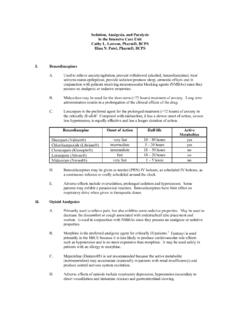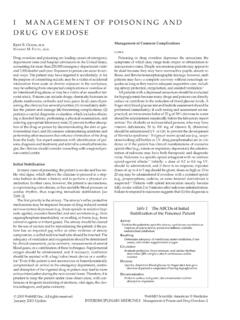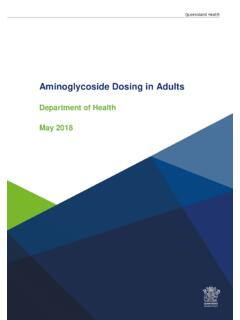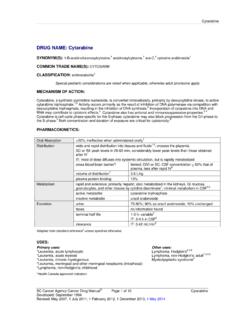Transcription of Bugs n drugs - Emory University
1 Bugs N drugs General Principles of Antimicrobial Therapy Hina N. Patel, , BCPS I. Basic Considerations a. Empiric treatment i. Site of infection ii. Likely pathogens iii. Hospital specific antibiogram b. Antibiotic spectrum of activity c. Penetration of antibiotic into body tissues d. Toxicity e. Allergies f. Cost II. Susceptibilities (MIC and MBC) a. MIC minimum inhibitory concentration (reported with culture) b. MBC minimum bactericidal concentration c. Relationship between drug concentration and MIC i. Must have concentrations at least 5-10 times the MIC to be susceptible ii. Susceptible, intermediate and resistant are based on peak concentration:MIC ratios iii.
2 Inhibitory index = peak concentration/MIC (should be 5-10) III. Resistance a. Mechanisms of resistance i. Antibiotic inactivation (beta lactamases) ii. Target site alteration by the bacteria (changes in PBPs and DNA gyrases) iii. Changes in the ability of the antibiotic to penetrate the cell wall of the bacteria b. Significant problems with Enterobacter, Klebsiella, Pseudomonas, Acineterbacter, Serratia, VRE, MRSA, TB IV. Combination Therapy a. Rationale for combination therapy i. Prevention of resistance to a single agent ii. treatment of polymicrobial infection iii. Empiric therapy in immunocompromised patient iv. Synergism with certain combinations b. Beta-lactam + aminoglycoside or quinolone combinations are effective c.
3 No good rationale to use double beta lactam therapy in most situations d. Benefit to combination therapy (synergy, decreased resistance, broader spectrum) e. Disadvantages include increased cost, superinfection, possible drug antagonism f. Pathogens usually requiring combination therapy i. Pseudomonas anti-pseudomonal beta lactam + aminoglycoside ii. Enterobacter iii. Serratia iv. Enterococcus (except for UTI) ampicillin or vancomycin + gentamicin PENICILLINS - bactericidal - interferes with peptide cross-linking required to produce stable cell walls - development of resistance due to beta lactamase production and changes in PBPs - may accumulate in renal failure and cause seizures - good tissue penetration (except prostate and uninflammed meninges) Natural Penicillin G (IV) Penicillin V (po) Non-penicillinase producing GPC and gram positive anaerobes S.
4 Pyogenes, S. pneumoniae, S. agalactiae, N. meningitides, Clostridium spp, corynebacterium Benzathine Penicillin (IM) Rheumatic fever, prophylaxis , syphilis Procaine Penicillin (IM) Pharyngitis Antistaphylococcal (Penicillinase resistant penicillins) Nafcillin (IV, po - Unipen) Dicloxacillin (po Dynapen; only useful oral agent) NOT FOR MRSA, MRSE OR ENTEROCOCCI Extended Spectrum Ampicillin (IV, po) Amoxicillin (po) Gram positive and gram negative coverage Streptococcus species (incl some Enterococci), Listeria, H.
5 Flu, E. coli Proteus mirabilis, Salmonella, Shigella DO NOT USE IF PENICILLINASE PRODUCING Combinations with beta-lactamase inhibitors: Non anti-pseudomonal Amoxicillin plus clavulanate (po - Augmentin) Extends H. flu and Staph coverage Ampicillin plus sulbactam (IV - Unasyn) Extends spectrum of ampicillin including B.
6 Fragilis and H. flu Anti-pseudomonal Ticarcillin plus clavulanate (IV Timentin) Pipercillin plus tazobactam (IV Zosyn) Pseudomonas spp; extends Enterobacteriaceae, Enterococci and B. fragilis CEPHALOSPORINS - DO NOT USE IN: MRSA, ENTEROCOCCI, LISTERIA MONOCYTOGENES - beta lactam antibiotics - act on cell wall similar to penicillins - divided into 4 generations based on antimicrobial spectrum - resistance via production of beta lactamases - 1st generation has good activity versus gram positive except MRSA and MRSE, and moderate activity versus community acquired gram negative such a E. coli and klebsiella - 2nd generation has intermediate activity versus gram positive and gram negative - 3rd generation has expanded activity versus the Enterobacteriaceae including those that produce beta lactamase - 4th generation (cefepime) has expanded gram negative coverage including pseudomonas spp.
7 ; no anaerobic coverage First Generation Cephalexin (po Keflex) Useful in cellulitis, osteomyelitis; alternative for UTI Cefazolin (IV Ancef, Kefzol) Useful in surgical prophylaxis Gram positive and some gram negative activity MSSA, S. pneumoniae, P. mirabilis, E. coli, K. pneumoniae Second Generation Cefuroxime (po, IV Ceftin, Zinacef) Community acquired infections Gram positive (pneumococci and S. aureus); increased activity against H. flu, E. coli, Klebsiella and Proteus Cefoxitin (IV Mefoxin) Increased anaerobic activity, including excellent B fragilis coverage Cefotetan (IV Cefotan) Anaerobes, including B fragilis Third Generation Cefotaxime (IV Claforan) Ceftriaxone (IV Rocephin) Meningitis and gram negative sepsis Excellent gram negative activity including all Enterobacteriaceae species, though most Enterobacter cloacae are now resistant DO NOT USE IN PSEUDOMONAS INFECTIONS Ceftazidime (IV Fortaz, Tazidime) Reserve for Pseudomonas spp.
8 Fourth Generation Cefepime (IV Maxipime) Pneumonia, gram negative sepsis and serious infections in immunocompromised Activity against most staph, strep, and most gram negative organisms including serratia, pseudomonas and enterobacter; NO ANAEROBES **Hematological effects secondary to N-methylthiotetrazole (NMTT) side chain: Causes hypoprothrombinemia by inhibiting Vit K dependent clotting factors Cefamandole, Cefoperazone, Cefotetan Causes disulfiram-like reaction to alcohol CARBAPENEMS - beta lactam antibiotic active against cell wall - broad spectrum active against gram positive (including ampicillin sensitive enterococci), gram negative (including pseudomonas spp.)
9 And anaerobes - no activity against MRSE, Stenotrophomonas maltophilia, Pseudomonas cepacia and MRSA - concentration dependent killing - for serious polymicrobial infections such as sepsis, infectious pancreatitis, pneumonia, soft tissue infections and peritonitis Imipenem (IV Primaxin) Slightly more activity versus gram positive and a little less activity with gram negative compared to meropenem Risk of seizures more common in renal failure Meropenem (IV Merrem) Similar spectrum of activity as imipenem Little or no risk of seizures MONOBACTAMS - beta lactam antibiotic active against cell wall - ONLY gram negative organisms including pseudomonas - no anaerobe or gram positive activity Aztreonam (IV- Azactam) AMINOGLYCOSIDES - interferes with bacterial protein synthesis - bactericidal with concentration dependent killing - active against most gram negative organisms including pseudomonas, serratia o Pseudomonas aeruginosa (combine with anti-pseudomonal penicillin) amikacin > tobramycin > gentamicin o Serratia (combine with third generation cephalosporin)
10 Gentamicin amikacin > tobramycin - for pneumonia, febrile neutropenia, UTI and pyelonephritis - used for synergy in combination with other antibiotics - main toxicities are nephrotoxicity and ototoxicity Gentamicin (IV Garamycin) Tobramycin (IV Nebcin) Amikacin (IV- Amikin) MACROLIDES - bacteriostatic - act on bacterial 50s ribosomal subunit affecting protein synthesis - very lipophilic and concentrate in macrophages (legionella, mycoplasma, bordotella and chlamydia - for community acquired pneumonia, atypical pneumonia, Chlamydia infections, strep infections, bacterial conjunctivitis, skin and soft tissue infections, HIV related infections and campylobacter enteritis Erythromycin (po, IV) Broad spectrum including gram positive organisms such as group A strep, S.)




